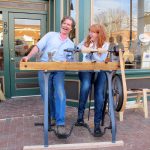We may receive a commission when you use our affiliate links. However, this does not impact our recommendations.
 About 30 years ago, I had this idea that there ought to be a book of measured drawings of Arts & Crafts period furniture, focusing on the designs of Gustav Stickley. Gus called his work “Craftsman” furniture, and I think that term is far more appropriate than “Mission” furniture. “Mission” was a term coined by a marketing guy, but “Craftsman” reflects what this style of furniture is all about – well-made, beautifully proportioned, honest and straightforward. It was my favorite style of furniture, and books of measured drawings were my favorite woodworking books.
About 30 years ago, I had this idea that there ought to be a book of measured drawings of Arts & Crafts period furniture, focusing on the designs of Gustav Stickley. Gus called his work “Craftsman” furniture, and I think that term is far more appropriate than “Mission” furniture. “Mission” was a term coined by a marketing guy, but “Craftsman” reflects what this style of furniture is all about – well-made, beautifully proportioned, honest and straightforward. It was my favorite style of furniture, and books of measured drawings were my favorite woodworking books.
I think the best way to learn design, or to learn about a particular style of furniture, is by studying good examples, and it seemed to me that somebody would come along and produce a book along the lines of John Kassay’s “The Book of Shaker Furniture,” John Shea’s “Making Authentic Shaker Furniture” or Thomas Moser’s “How to Build Shaker Furniture.” After 20 years of studying, building and making technical drawings, I began to think that maybe that somebody was me, and I wrote “Shop Drawings for Craftsman Furniture.”
At the time, I hadn’t thought beyond a single book, but one thing led to another and “More Shop Drawings for Craftsman Furniture” was published a year later. As I was wrapping up work on that, my publisher asked if we could throw in some pages about Craftsman-style kitchens. Where it took 20 years to come up with the first book, it took less than 20 minutes to come up with the third. I said there was enough good kitchens, other built-ins and architectural stuff for an entire book, and that Columbia University had many of Stickley’s drawings for those things down in the basement of their architectural library. And so “Shop Drawings for Craftsman Interiors” came to be. The final piece of the puzzle was the inlay designs created by Harvey Ellis, and the patterns for the hand-hammered copper hardware typical of the period. Shortly after signing off on “Shop Drawings for Craftsman Inlays & Hardware” eight years ago, I came to work for Popular Woodworking Magazine.
 I’m finishing up my work on a new book that is a compilation of the first, second and fourth books with a working title of “The Complete Book of Shop Drawings for Craftsman Furniture.” Release date and price are still fuzzy at this point, but this book will be available sometime this summer. If you already have all of these books, I thank you and I’ll understand if you pass this one by. If, on the other hand you only have one, or have an interest in building Arts & Crafts furniture, I’ll think you’ll want to add this new book to your library.
I’m finishing up my work on a new book that is a compilation of the first, second and fourth books with a working title of “The Complete Book of Shop Drawings for Craftsman Furniture.” Release date and price are still fuzzy at this point, but this book will be available sometime this summer. If you already have all of these books, I thank you and I’ll understand if you pass this one by. If, on the other hand you only have one, or have an interest in building Arts & Crafts furniture, I’ll think you’ll want to add this new book to your library.
The new book contains all of the furniture drawings of the first two books, as well as all of the inlay and hardware drawings. The introductory text of all three books has been combined, so good information that was once scattered across the three is now nicely organized into chapters on the history of the furniture, the people who made it and how to make reproductions in the modern shop. We’re also adding a lot of new images to the introduction, including photos of vintage pieces, photos and illustrations from period publications, and detailed photos of woodworking techniques.
You’ll see more information here on the Popular Woodworking Magazine editor’s blog about this book in the weeks to come, as well as some other Arts & Crafts projects we have cooking, and it will be available at our store shopwoodworking.com.
Here are some supplies and tools we find essential in our everyday work around the shop. We may receive a commission from sales referred by our links; however, we have carefully selected these products for their usefulness and quality.










Robert, Is there any chance you may add a drawing or two? The Gamble dining table and chairs are nowhere to be found. Any specific reason why what may be regarded as their premier piece has never been done?
Are your first three books still in print? The four together would make a nice reference set.
SWMBO also likes contemporary, Danish Modern, and Asian. So, I’m percolating blends of G & G with contemporary / Modern / Asian in the back of my mind. Looks like it’s time to break out Sketch-up again.
I have your book on Greene & Greene, which She Who Must Be Obeyed likes much more so than straight-line Stickley. So, sorry, I’ll have to pass this one up for the time being. (And, as a long-ago liberal arts grad, I took a second major in history. Darn!)
Say, Bob, here’s a blithering idea for you. If you have nothing else to do the week-end of March 31/April1, you might want to consider hitching a ride with Ron Herman, who will be doing some teaching at the NWA in Saratoga Springs, NY. On the way over, you guys can get off at the Syracuse exit of the Thruway and go to The Stickley Museum, which is located on the 2nd floor of the original L. & J.G. Stickley Factory at 300 Orchard Street, Fayetteville, N.Y. 13066, above the Fayetteville Free Library, just a few miles outside of Syracuse. Free cups of really good coffee added as a bonus if you do so. Just a thought.
Awesome, I’ll want to be pre-ordering that one!